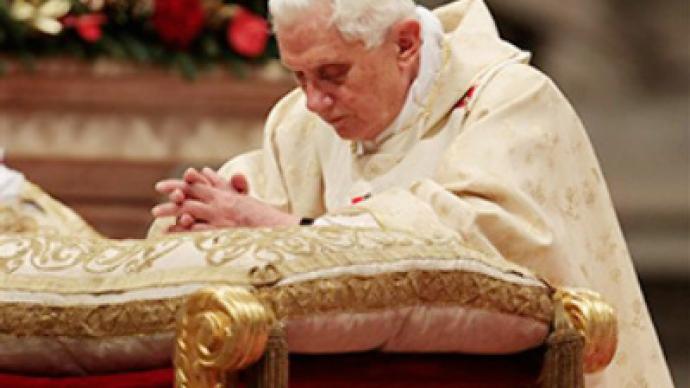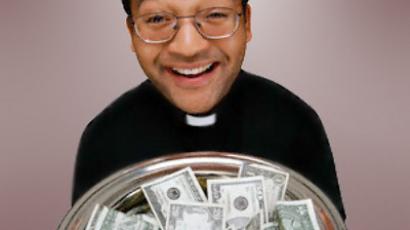Vatican asking: Why the Pope, why now?

The Holy See, reeling from media reports that say Pope Benedict XVI failed to prevent child abuse incidences when he was a Cardinal, is looking at conspiracy theories to explain events.
First, it must be said that the media’s timing for leveling explosive charges against the Papal office – in the middle of Holy Week and on the eve of Easter, Christianity’s holiest feast day – could not have been more damaging for the Catholic Church. In terms of religious relativism, this was the equivalent of leveling charges against rabbis during Hanukah, or against clerics during Ramadan.
This leads to a disturbing question: was the media assault an orchestrated attack, designed to inflict as much damage on the Catholic Church as possible?
The fireworks began when The New York Times published a story (March 24, 2010) alleging that top Vatican officials, including Cardinal Joseph Ratzinger, the future pope, “did not defrock a priest who molested as many as 200 deaf boys, even though several American bishops repeatedly warned them that failure to act on the matter could embarrass the church, according to church files newly unearthed as part of a lawsuit.”
The story is in reference to one Father Murphy, who abused up to 200 deaf children while working at a school in the Milwaukee Archdiocese from 1950 to 1974. But this news, albeit very unfortunate, is old news. The real objective of the New York Times piece was to show that Cardinal Joseph Ratzinger did not take the appropriate measures, including informing the police, as to the criminal behaviour of Fr. Murphy.
Those media charges now look highly suspect.
Cardinal William J. Levada, Prefect of the Congregation for the Doctrine of the Faith, spoke out against the New York Times’ “attack mode” on the official Vatican website, saying the publication was “deficient by any reasonable standards of fairness that Americans have every right and expectation to find in their major media reporting.”
Cardinal Levada went on to lament that Laurie Goodstein, the author of the piece, only informs readers deep into her story that the disgraced Fr. Murphy “not only was never tried or disciplined by the church’s own justice system, but also got a pass from the police and prosecutors who ignored reports from his victims, according to the documents and interviews with victims.”
In other words, the Vatican never concealed the facts of the case from the police, as the critics have been attempting to suggest, and therefore there was never an attempt at a “cover up” on the part of the present Pope.
Levada argues that “the point of Goodstein’s article… is to attribute the failure to accomplish this dismissal to Pope Benedict, instead of to diocesan decisions at the time. She uses the technique of repeating the many escalating charges and accusations from various sources (not least from her own newspaper), and tries to use these “newly unearthed files” as the basis for accusing the pope of leniency and inaction in this case and presumably in others.”
But instead of the charges against the Pope subsiding, they snowballed and spread across the ocean, leading to revelations of other abuse cases, notably in Ireland and Germany. The sudden coordination of the attacks, coming from so many diverse locations, suggested to some church leaders that something greater than just the media was at play. Indeed the “sophistication” of the attacks, according to at least one Vatican official, points to the machinations of “external forces.”
A “Zionist attack?”
One individual who is suspicious of the origins of the attack is Monsignor Giacomo Babini, the Bishop Emeritus of Grossetto. He was quoted by the Italian Roman Catholic website Pontifex as saying that he believed a “Zionist attack” was behind the criticism of the Pope, considering that it was “powerful and refined” in nature.
Meanwhile, Giovanni Maria Vian, the Editor of L’Osservatore Romano, the Vatican newspaper, agreed that there was a concerted media campaign against the Pope, but suggestions that Jews were behind it were “ridiculous.”
Given this line of suspicion, it was interesting that Father Raniero Cantalamessa, in a Friday sermon in St Peter's Basilica, said attacks on the Catholic Church (anti-Catholicism) and the Pope were comparable to “collective violence” against Jews.
Whatever the case may be, the Catholic Church has received its fair share of bad publicity of late, and it seems that the Vatican will no longer take the criticism sitting down.
In an editorial, L’Osservatore Romano, the official Vatican newspaper, accused “the media” of having the “rather obvious and ignoble intention of attacking Benedict XVI and his closest collaborators at all costs.”
These sentiments were echoed by the popular Archbishop of New York, Timothy Dolan, who accused the Times of “being part of a well-oiled campaign against Pope Benedict.”
Even the Pope could not resist taking a swipe at his critics, telling his flock to be wary of “the petty gossip of dominant opinion” during his Palm Sunday liturgy.
Is the Catholic Church uniquely corrupt?
The Vatican is now in crisis mode, trying to prove that it is in the business of saving souls, not preying on innocent children. Happily for the Vatican, it is not just the Catholic Church that is susceptible to such unfortunate incidences, according to recent research.
It has been estimated that in the last 50 years somewhere between 1.5% and 5% of the Catholic clergy has been involved in sexual abuse cases, “a figure that is comparable with that of other groups and denominations,” Archbishop Silvano Maria Tomasi reminded his flock in September last year.
In a peer-reviewed article from 2007, Professor T. Plante and Courtney Daniels, specialists in sexual abuse cases from Santa Clara University, California wrote that: “Our best estimates suggest that the percentage of sex-offending Roman Catholic priests likely also applies to clergy members from other religious traditions such as Jews, Muslims and Protestant denominations.”
Yet the concerted effort to demonize the Holy See went to a whole new level on Tuesday as Richard Dawkins and Christopher Hitchens, two prominent atheist intellectuals, said they want the Pope to be arrested when he visits the United Kingdom in September.
“I'm convinced we can get over the threshold of immunity,” their lawyer Mark Stephens told The Guardian. “The Vatican is not recognized as a state in international law. People assume that it has existed for time immemorial but it was a construct of Mussolini, and when the Vatican first applied to become a member of the UN, the US said no. So as a sop they were given the status of permanent observers rather than full members.”
Dawkins, author of The God Delusion, has confirmed he is seeking Pope Benedict’s arrest, but would not attempt to perform a "citizens arrest." The Pope is known to travel with the largest security apparatus in the world.
Last month, Dawkins penned a scurrilous article for the Washington Post in which he called the Bishop of Rome: “A leering old villain in a frock, who spent decades conspiring behind closed doors for the position he now holds; a man who believes he is infallible and acts the part.”
Time will tell whether the Vatican will weather the storm against such frivolous attacks, or whether it will be forced to get its house in order and change some of its age-old traditions.













